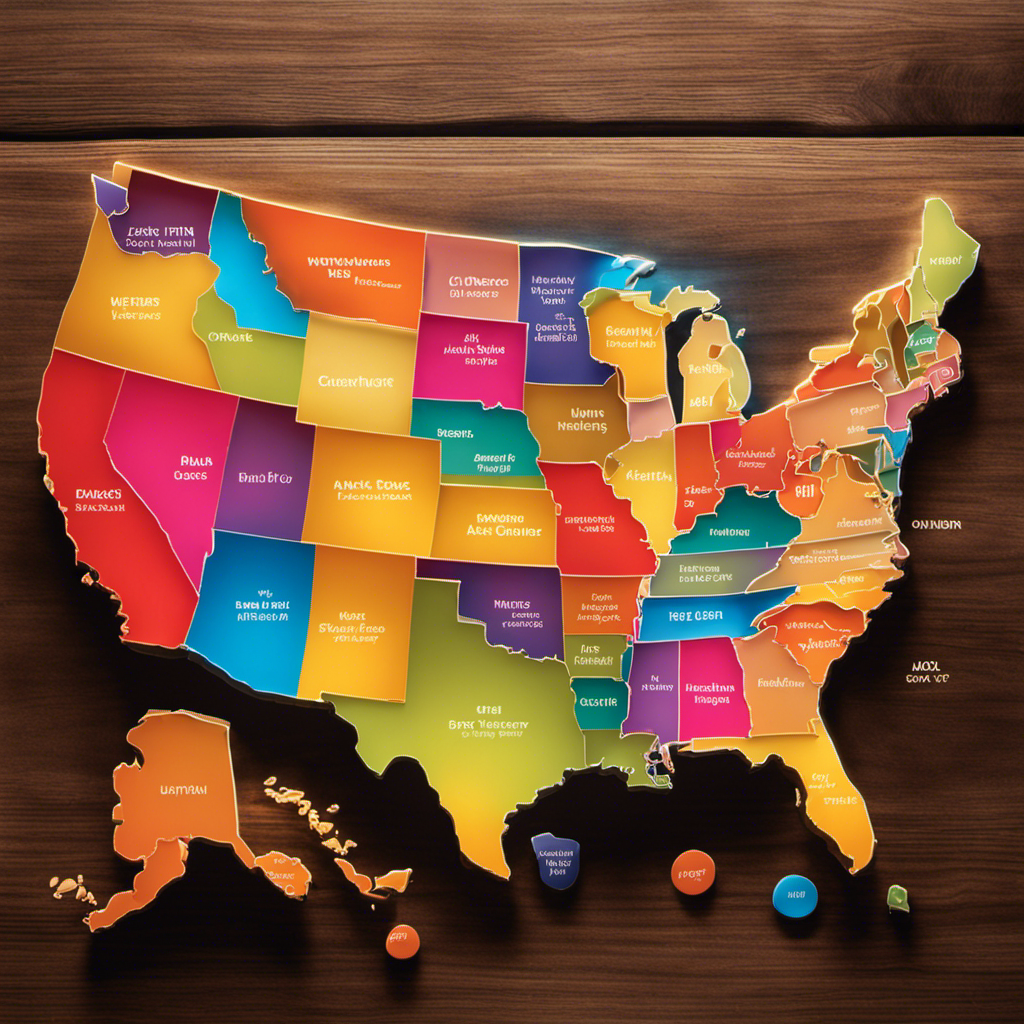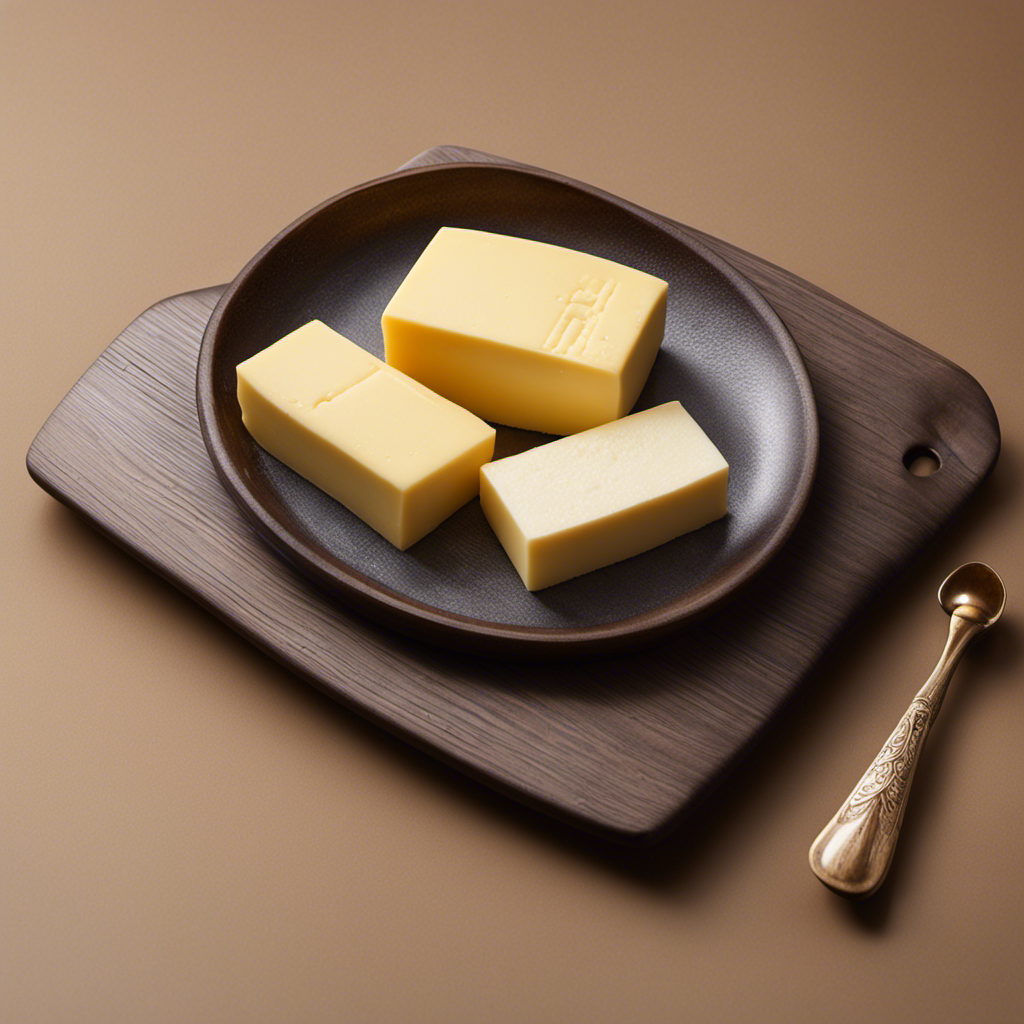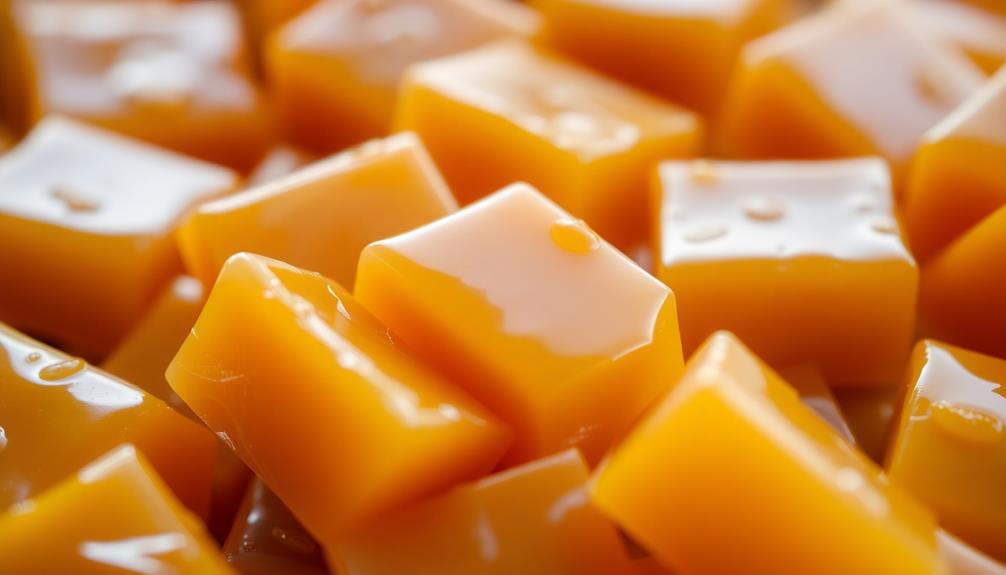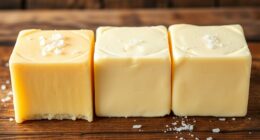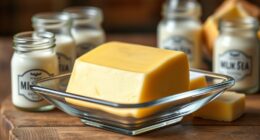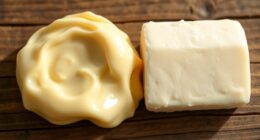Hello!
Have you ever wondered what sets European style butter apart from its regular counterpart? Well, get ready to have your taste buds tantalized and your culinary horizons expanded.
In this article, I’ll be taking you on a journey to discover the creamy, rich, and oh-so-delectable world of European style butter. From its origins to its unique characteristics, we’ll delve into why this butter is a game-changer in the kitchen.
So, let’s grab our aprons and dive right in!
Key Takeaways
- European style butter has a higher fat content, resulting in a richer and creamier texture.
- It is perfect for baking, spreading on toast, or adding to sauces.
- European style butter is favored by bakers and pastry chefs for its decadent taste and mouthfeel.
- The lower moisture content in European style butter leads to flakier pastries and more tender cakes.
Understanding European Style Butter
European style butter is known for its high fat content and creamy texture. Understanding different butter types can help elevate your culinary creations to the next level.
European style butter has a higher fat content than traditional American butter, typically around 82% or more. This higher fat content results in a richer and creamier texture, making it perfect for baking, spreading on toast, or adding to sauces.
The benefits of using European style butter are numerous. Its higher fat content lends to a more decadent taste and mouthfeel, making it a favorite among bakers and pastry chefs. Additionally, the higher fat content also means that European style butter has a lower moisture content, resulting in flakier pastries and more tender cakes.
The Origins of European Style Butter
Did you know that the origins of that rich, creamy butter you love can be traced back to a specific region?
European style butter, known for its high fat content and luxurious texture, has a long history that starts in Northern Europe. This region, with its lush pastures and cool climate, provided the perfect conditions for raising dairy cows and producing high-quality milk.
The production process of European style butter involves churning the cream for an extended period of time, which creates a higher butterfat content and gives it that distinct smoothness. These traditional methods have been passed down through generations, ensuring that European style butter maintains its exceptional taste and consistency.
Now, let’s delve into the key differences in European style butter compared to other types.
Key Differences in European Style Butter
When it comes to butter, you’ll notice that the key differences in this rich and creamy spread can be found in its high fat content and luxurious texture. European style butter, in particular, stands out for its unique characteristics. Here’s what sets it apart:
-
Higher fat content: European style butter typically contains a higher fat content compared to regular butter. This gives it a richer flavor and creamier texture, making it perfect for spreading on bread or adding to baked goods.
-
Creamier texture: The higher fat content in European style butter results in a smoother and silkier texture. It melts effortlessly, creating a luscious and velvety mouthfeel that enhances the overall taste of any dish.
-
Understanding the benefits: Due to its higher fat content, European style butter can bring several benefits. It adds richness and depth to recipes, enhances the flavor of ingredients, and helps create a flakier texture in pastries and pie crusts.
In terms of nutritional differences, European style butter may contain slightly more calories and saturated fat compared to regular butter. However, it also offers a higher concentration of fat-soluble vitamins like vitamin A and E. It’s important to enjoy it in moderation as part of a balanced diet.
Characteristics of European Style Butter
When it comes to butter, there’s a clear distinction between richness and regularity.
European Style Butter (ESB) takes butter to a whole new level of decadence, with its higher butterfat content and creamy texture.
This richness makes ESB a go-to ingredient for culinary applications, elevating everything from pastries to sauces with its distinctive flavor and luxurious mouthfeel.
Richness Vs. Regular Butter
You’ll notice the difference in richness when you compare European style butter to regular butter. Here are three reasons why European style butter is preferred by many:
-
Higher butterfat content: European style butter typically contains a higher percentage of butterfat compared to regular butter. This results in a creamier and more luxurious texture, making it perfect for spreading on warm toast or baking delectable pastries.
-
Unique flavor profile: European style butter has a distinctively rich and nutty flavor. The cows in Europe are often grass-fed, which contributes to the butter’s unique taste. This flavor profile adds depth and complexity to your culinary creations.
-
Creamier texture: Due to its higher butterfat content, European style butter has a smoother and silkier texture. It melts more evenly and easily, giving your dishes a velvety smoothness that regular butter may lack.
When it comes to richness and indulgence, European style butter is the clear winner. Its higher butterfat content, unique flavor profile, and creamier texture make it the preferred choice for those seeking a truly indulgent butter experience.
Culinary Applications of ESB
To enhance the richness of your culinary creations, consider using European style butter in a variety of dishes. European style butter is known for its high fat content and creamy texture, making it perfect for baking, sautéing, and spreading on bread. Its rich flavor adds depth to both sweet and savory dishes, making it a versatile ingredient in the kitchen.
When it comes to culinary techniques, European style butter excels in techniques such as browning, where the high fat content gives it a beautiful golden color and rich aroma. It also works wonderfully in emulsions, like hollandaise sauce or pastry cream, where the high fat helps create a smooth and velvety consistency.
In terms of flavor pairings, European style butter pairs well with a wide range of ingredients. Its creamy and slightly tangy taste complements both sweet and savory flavors. For example, it can be used to enhance the richness of a chocolate cake or to bring out the flavors of fresh herbs in a compound butter.
Why Choose European Style Butter
If you’re looking for a richer and creamier taste, European style butter is the perfect choice for you. Made with a higher butterfat content, European style butter offers a multitude of benefits that will elevate your culinary creations to a whole new level.
Here are three reasons why you should consider incorporating this delicious butter into your cooking:
-
Superior Taste: European style butter has a distinct flavor that is often described as nutty and complex. Its higher butterfat content gives it a smooth and velvety texture, making it perfect for spreading on bread or melting into a sauce.
-
Creamier Texture: The higher butterfat content also means that European style butter has a richer and creamier texture. This makes it ideal for baking, as it creates tender and moist pastries, cakes, and cookies.
-
Versatility: European style butter is incredibly versatile and can be used in a wide range of dishes. Whether you’re making a savory sauce, a sweet dessert, or simply spreading it on toast, this butter will add a delightful richness and depth of flavor.
How European Style Butter Is Made
When it comes to making European style butter, it’s all about the traditional churned process. This method involves slowly churning the cream until it separates into butter and buttermilk, resulting in a rich and velvety texture.
One of the reasons why European style butter stands out is its higher fat content, which gives it a distinctively creamy and indulgent taste. Trust me, once you try this butter, you’ll never want to go back to anything else.
Traditional Churned Process
The traditional churned process gives European style butter its rich and creamy texture. As someone who loves cooking and baking, I appreciate the benefits of using European style butter. Here are three reasons why it’s worth considering:
-
Higher Fat Content: European style butter contains a higher percentage of butterfat compared to regular butter. This means it has a higher melting point, resulting in better texture and moisture retention in baked goods.
-
Rich Flavor: The longer churning process of European style butter develops a deeper, more complex flavor profile. It adds a luxurious taste to everything it’s used in, from simple toast to decadent pastries.
-
Creamier Consistency: The slow churning process creates smaller butterfat particles, giving European style butter a smoother and creamier consistency. It spreads effortlessly on bread and melts beautifully in sauces.
Higher Fat Content
You’ll love the higher fat content in this butter – it gives your baked goods a perfect texture and moisture retention.
European style butter, with its rich and creamy consistency, is a culinary delight that adds a touch of luxury to any dish. Its higher fat content, typically around 82%, makes it ideal for baking and adds a velvety smoothness to your pastries and cakes.
The increased fat also enhances the flavor and richness of your dishes, creating a truly indulgent experience. But it’s not just about taste; European style butter also offers health benefits. It contains essential fatty acids and fat-soluble vitamins, which are important for brain health and nutrient absorption.
Creamier and Richer Taste
European style butter is known for its exceptional creaminess factor, which sets it apart from regular butter. Its creamier and richer taste adds a luxurious touch to any culinary creation. Here are three reasons why its creaminess factor makes it a must-have in the kitchen:
-
Enhanced Flavors: The higher fat content in European style butter enhances the flavors of your dishes, making them more indulgent and satisfying. Whether you’re baking pastries or sautéing vegetables, the creamy taste elevates every bite.
-
Smooth Texture: The smooth and velvety texture of European style butter spreads effortlessly on bread or melts smoothly in sauces. It adds a luscious mouthfeel to your dishes, creating a luxurious dining experience.
-
Perfect for Sauces and Spreads: The creaminess of European style butter makes it ideal for creating rich and creamy sauces like hollandaise or beurre blanc. It also enhances the taste of spreads like garlic butter or herb-infused compound butter.
With its creaminess factor and culinary advantages, European style butter is a game-changer in the kitchen. Elevate your dishes and impress your guests with its rich and luxurious taste.
The Creamy Texture of European Style Butter
Experience the rich and velvety texture of European style butter. When you take a bite of a pastry made with this butter, you are instantly greeted with a luxurious mouthfeel that is unmatched.
The benefits of using European style butter in your baking are numerous. Its higher fat content, typically around 82%, lends to a creamier and richer taste. This butter is made by churning cream for a longer period of time, resulting in its smooth and silky texture.
If you want to make European style butter at home, it’s fairly simple. Start by using high-quality heavy cream, and then whip it until it separates into butter and buttermilk. Strain the mixture to remove the liquid, and you’re left with delicious homemade European style butter.
With its decadent texture, European style butter adds a touch of luxury to any recipe. But how does it compare to regular butter? Let’s find out.
European Style Butter Vs. Regular Butter
When it comes to European Style Butter versus Regular Butter, there are some noticeable flavor differences that can really elevate your culinary creations.
European Style Butter has a rich, indulgent taste with a higher fat content and a slightly tangy flavor profile.
Regular Butter, on the other hand, has a milder taste and is often used for everyday cooking and baking.
Understanding these flavor differences can help you decide which butter is best suited for your specific recipes and culinary needs.
Flavor Differences Explained
There’s a noticeable difference in flavor between European-style butter and regular butter. When it comes to flavor profiles, European-style butter stands out with its rich, creamy, and slightly tangy taste. It has a higher fat content, which contributes to its luxurious texture and distinct flavor. This butter is deeply rooted in European culinary traditions and holds great cultural significance in the region.
Here are three reasons why European-style butter is so unique:
-
Intense Creaminess: The higher fat content gives European-style butter a velvety smoothness that melts in your mouth.
-
Delicate Tang: The slight tanginess adds a pleasant zing to dishes, making them more vibrant and flavorful.
-
Complex Aromas: European-style butter has a more pronounced and complex aroma, enhancing the overall taste experience.
Now that we understand the flavor differences, let’s explore the best uses for each type of butter.
Best Uses for Each
Now that we know the flavor differences between European style butter and American style butter, let’s talk about the best uses for each. Whether you’re spreading it on toast or using it in recipes, choosing the right butter can make a big difference in the taste and texture of your dishes. To help you decide which butter to use, here’s a handy table that outlines the best uses and flavor pairings for each type:
| European Style Butter | American Style Butter |
|---|---|
| Spreading on bread | Baking |
| Making croissants | Cookies |
| Whipping into buttercream | Pie crusts |
| Finishing sauces and gravies | Pancakes |
| Incorporating into pastries | Brownies |
Using European Style Butter in Baking
If you want to take your baking to the next level, you should consider using European style butter. This rich and creamy butter is a game-changer when it comes to creating delicious pastries. Here are three reasons why using European style butter in your baking will elevate your creations:
-
Higher fat content: European style butter typically has a higher fat content than regular butter, which means it adds more richness and flavor to your pastries.
-
Creamier texture: The higher fat content also gives European style butter a creamier texture, resulting in melt-in-your-mouth pastries that are incredibly indulgent.
-
Enhanced flavor: European style butter has a unique, slightly tangy flavor that adds depth to your baked goods. It brings out the flavors of other ingredients and creates a more complex taste profile.
By incorporating European style butter into your baking, you’ll enjoy the benefits of its higher fat content, creamier texture, and enhanced flavor.
Now, let’s explore the flavor profile of European style butter in more detail.
Exploring the Flavor Profile of European Style Butter
Let’s dive into the unique taste of using European style butter in your baking.
European style butter is known for its distinct flavor characteristics that can elevate your baked goods to a whole new level. One of the key flavor characteristics of European style butter is its rich and creamy taste. This is due to its higher fat content, which gives it a velvety texture and a luxurious mouthfeel.
When used in baking, this butter imparts a deep, buttery flavor that enhances the overall taste of your treats. In addition to its flavor, European style butter also offers culinary benefits. Its higher fat content makes it ideal for creating flaky pastries, tender cakes, and rich, buttery cookies.
Incorporating European Style Butter in Cooking Recipes
Using European style butter in your cooking recipes can add a rich and creamy flavor that takes your dishes to a whole new level. Not only does it elevate the taste of your meals, but it also brings several benefits to your culinary creations. Here are three reasons why incorporating European style butter in your desserts and other recipes is a game-changer:
-
Enhanced Flavor: European style butter has a higher butterfat content, resulting in a more intense and luxurious taste. It adds depth and complexity to your desserts, making them irresistibly indulgent.
-
Creamier Texture: The higher butterfat content also contributes to a smoother and silkier texture in your desserts. From silky custards to velvety cakes, European style butter lends a luscious mouthfeel that will have your guests swooning.
-
Better Baking Results: European style butter has a lower water content, which means it produces less steam during baking. This results in flakier pie crusts, more tender pastries, and perfectly golden cookies.
Frequently Asked Questions
What Are the Different Types of European Style Butter Available in the Market?
There are various types of European style butter available in the market. They are known for their rich and creamy texture, higher butterfat content, and distinct flavor. Using European butter can enhance the taste of your dishes and make them more delicious.
Can European Style Butter Be Used as a Spread on Bread or Toast?
Yes, European style butter can be used as a spread on bread or toast. It has a rich and creamy flavor profile compared to regular butter, and it holds cultural significance in various cuisines.
Is European Style Butter More Expensive Than Regular Butter?
European style butter is worth the higher price due to its luxurious texture and higher fat content. It is made using a traditional European method, resulting in a creamier, richer flavor.
Can European Style Butter Be Used as a Substitute for Regular Butter in Recipes?
European style butter has a rich and creamy flavor that adds depth to any recipe. It can be used as a substitute for regular butter in baking, providing a luxurious texture and enhancing the overall taste.
Are There Any Health Benefits Associated With Consuming European Style Butter?
European style butter has a rich, creamy taste and a smooth, velvety texture. It is higher in fat content compared to regular butter, which gives it a more luxurious mouthfeel. As for health benefits, it contains vitamins A, D, and E, which are essential for overall wellbeing.
Conclusion
In conclusion, European style butter is a revelation for butter lovers everywhere. Its rich and creamy texture, combined with its indulgent taste, elevates any dish it touches to new heights of deliciousness. Once you’ve experienced the velvety smoothness and unparalleled richness of European style butter, there’s no going back to regular butter.
Whether you’re using it in baking or cooking, this butter is a game-changer. So go ahead, treat yourself to the luxuriousness of European style butter and prepare to be amazed.

